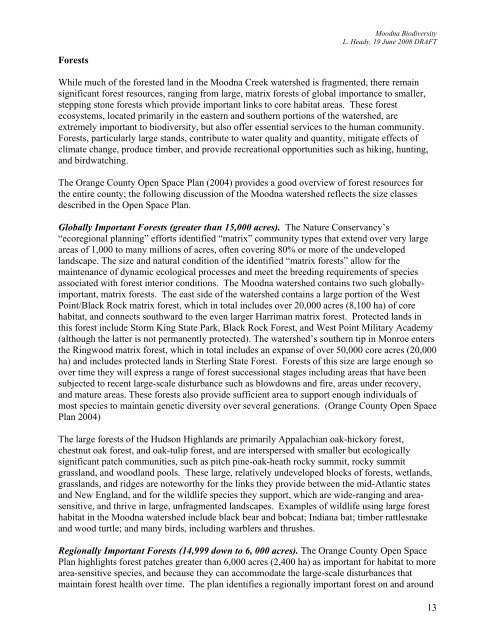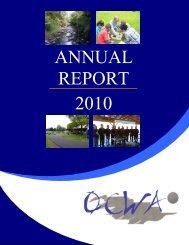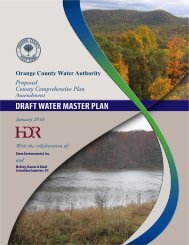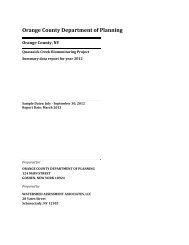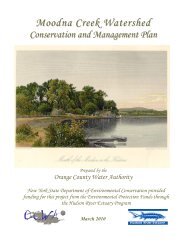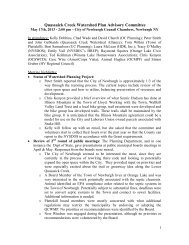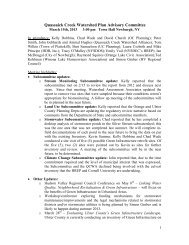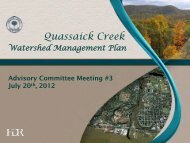Biodiversity of the Moodna Creek Watershed - Orange County Water ...
Biodiversity of the Moodna Creek Watershed - Orange County Water ...
Biodiversity of the Moodna Creek Watershed - Orange County Water ...
You also want an ePaper? Increase the reach of your titles
YUMPU automatically turns print PDFs into web optimized ePapers that Google loves.
<strong>Moodna</strong> <strong>Biodiversity</strong><br />
L. Heady, 19 June 2008 DRAFT<br />
Forests<br />
While much <strong>of</strong> <strong>the</strong> forested land in <strong>the</strong> <strong>Moodna</strong> <strong>Creek</strong> watershed is fragmented, <strong>the</strong>re remain<br />
significant forest resources, ranging from large, matrix forests <strong>of</strong> global importance to smaller,<br />
stepping stone forests which provide important links to core habitat areas. These forest<br />
ecosystems, located primarily in <strong>the</strong> eastern and sou<strong>the</strong>rn portions <strong>of</strong> <strong>the</strong> watershed, are<br />
extremely important to biodiversity, but also <strong>of</strong>fer essential services to <strong>the</strong> human community.<br />
Forests, particularly large stands, contribute to water quality and quantity, mitigate effects <strong>of</strong><br />
climate change, produce timber, and provide recreational opportunities such as hiking, hunting,<br />
and birdwatching.<br />
The <strong>Orange</strong> <strong>County</strong> Open Space Plan (2004) provides a good overview <strong>of</strong> forest resources for<br />
<strong>the</strong> entire county; <strong>the</strong> following discussion <strong>of</strong> <strong>the</strong> <strong>Moodna</strong> watershed reflects <strong>the</strong> size classes<br />
described in <strong>the</strong> Open Space Plan.<br />
Globally Important Forests (greater than 15,000 acres). The Nature Conservancy’s<br />
“ecoregional planning” efforts identified “matrix” community types that extend over very large<br />
areas <strong>of</strong> 1,000 to many millions <strong>of</strong> acres, <strong>of</strong>ten covering 80% or more <strong>of</strong> <strong>the</strong> undeveloped<br />
landscape. The size and natural condition <strong>of</strong> <strong>the</strong> identified “matrix forests” allow for <strong>the</strong><br />
maintenance <strong>of</strong> dynamic ecological processes and meet <strong>the</strong> breeding requirements <strong>of</strong> species<br />
associated with forest interior conditions. The <strong>Moodna</strong> watershed contains two such globallyimportant,<br />
matrix forests. The east side <strong>of</strong> <strong>the</strong> watershed contains a large portion <strong>of</strong> <strong>the</strong> West<br />
Point/Black Rock matrix forest, which in total includes over 20,000 acres (8,100 ha) <strong>of</strong> core<br />
habitat, and connects southward to <strong>the</strong> even larger Harriman matrix forest. Protected lands in<br />
this forest include Storm King State Park, Black Rock Forest, and West Point Military Academy<br />
(although <strong>the</strong> latter is not permanently protected). The watershed’s sou<strong>the</strong>rn tip in Monroe enters<br />
<strong>the</strong> Ringwood matrix forest, which in total includes an expanse <strong>of</strong> over 50,000 core acres (20,000<br />
ha) and includes protected lands in Sterling State Forest. Forests <strong>of</strong> this size are large enough so<br />
over time <strong>the</strong>y will express a range <strong>of</strong> forest successional stages including areas that have been<br />
subjected to recent large-scale disturbance such as blowdowns and fire, areas under recovery,<br />
and mature areas. These forests also provide sufficient area to support enough individuals <strong>of</strong><br />
most species to maintain genetic diversity over several generations. (<strong>Orange</strong> <strong>County</strong> Open Space<br />
Plan 2004)<br />
The large forests <strong>of</strong> <strong>the</strong> Hudson Highlands are primarily Appalachian oak-hickory forest,<br />
chestnut oak forest, and oak-tulip forest, and are interspersed with smaller but ecologically<br />
significant patch communities, such as pitch pine-oak-heath rocky summit, rocky summit<br />
grassland, and woodland pools. These large, relatively undeveloped blocks <strong>of</strong> forests, wetlands,<br />
grasslands, and ridges are noteworthy for <strong>the</strong> links <strong>the</strong>y provide between <strong>the</strong> mid-Atlantic states<br />
and New England, and for <strong>the</strong> wildlife species <strong>the</strong>y support, which are wide-ranging and areasensitive,<br />
and thrive in large, unfragmented landscapes. Examples <strong>of</strong> wildlife using large forest<br />
habitat in <strong>the</strong> <strong>Moodna</strong> watershed include black bear and bobcat; Indiana bat; timber rattlesnake<br />
and wood turtle; and many birds, including warblers and thrushes.<br />
Regionally Important Forests (14,999 down to 6, 000 acres). The <strong>Orange</strong> <strong>County</strong> Open Space<br />
Plan highlights forest patches greater than 6,000 acres (2,400 ha) as important for habitat to more<br />
area-sensitive species, and because <strong>the</strong>y can accommodate <strong>the</strong> large-scale disturbances that<br />
maintain forest health over time. The plan identifies a regionally important forest on and around<br />
13


